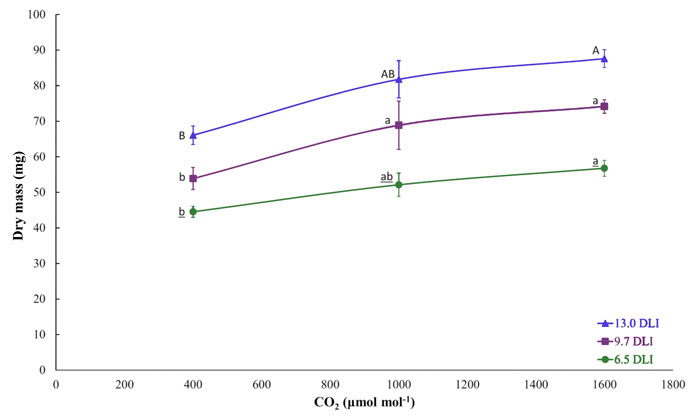| Tweet | Follow @co2science |
Paper Reviewed
Huber, B.M., Louws, F.J. and Hernández, R. 2021. Impact of different daily light integrals and carbon dioxide concentrations on the growth, morphology, and production efficiency of tomato seedlings. Frontiers in Plant Science 12: 615853, doi: 10.3389/fpls.2021.615853.
Prior studies have shown that high CO2 levels can often ameliorate growth and dry mass declines caused by low (or excessively high) light intensity under field or laboratory conditions by increasing the net photosynthetic rate. This topic was the recent investigation of Huber et al. (2021), who examined the impact of elevated CO2 on the growth of tomato seedlings (Solanum lycopersicum) in a controlled environment.
In defining their objectives, the three researchers hailing from the Department of Horticultural Sciences at North Carolina State University (Raleigh, North Carolina, USA) sought to "determine whether CO2 enrichment can maintain desirable plant growth under reduced light levels while maintaining comparable energy consumption, production cost, and high quality seedlings," while also seeking to "determine whether CO2 enrichment can reduce the production time of tomato transplants through an increased growth rate."
The work was conducted indoors under controlled-environment conditions and focused on the early, exponential phase of growth up until the grafting phase (16-18 days following germination) where there is no plant-to-plant competition. In all, four tomato cultivars were utilized in the study (Rebelski, Florida-47 R, Maxifort and Shin Cheong Gang) and data from each were pooled together for analysis. Three CO2 and three light intensity treatments were applied in a full-factorial design. For CO2, concentrations included 448 ppm (ambient), 1010 ppm (elevated) and 1568 ppm (super elevated), which concentrations were applied during lighted hours only (during the dark period the chambers were all ventilated to return the CO2 level to ~400 ppm). For light intensity, three levels with an 18-hour photoperiod were applied with photosynthetic photon flux densities of 100, 150 and 200 umol per square meter per second, which provided respective daily light integrals (DLIs) of 6.5, 9.7 and13.0 mol per square meter per day, representing very low, low and normal DLIs respectively.
So what did the study reveal?
Tomato seedling growth increased with increases in DLI and CO2 concentration. Net photosynthesis, fresh mass and dry mass (see Figure 1 below), for example, rose by an average 66%, 16% and 53%, respectively, under all CO2 treatments when the DLI increased from 6.5 to 13 mol per square meter per day. Similarly under all DLI treatments when the CO2 concentration rose from 448 to 1568 ppm net photosynthesis, fresh mass and dry mass increased by an average 52%, 20% and 33%, again respectively. And when combined, the simultaneous rise in DLI and CO2 increased these three parameters by a whopping 165% (net photosynthesis), 36% (fresh mass) and another whopping 165% (dry mass). What is more, Huber et al. report that CO2 enrichment to 1010 ppm and 1568 ppm enhanced the light use efficiency (grams of dry matter per mol of light applied) of the tomato seedlings by a respectable 38-44%, confirming that elevated CO2 can and does counter the growth-retarding effects of low light levels. And of this finding the authors say it highlights "the potential of decreasing the light requirement of plants (25-50%) through CO2 enrichment without affecting the quality of the transplants."
With respect to CO2 effects on plant morphology measures, Huber et al. report "on average, the hypocotyl, epicotyl, and total heights increased by 24% in response to CO2 enrichment." Further, tomato seedling leaf numbers and stem diameters in the super elevated treatment increased by 8% and 11%, respectively, compared to the ambient treatment. Lastly, the researchers found that elevated CO2 reduced the production time to the grafting phase by approximately 6-12%.
The results presented above demonstrate several of the many wonders of atmospheric CO2 enrichment that are benefitting plants as the air's CO2 concentration rises. Specific to this study, Huber et al. point out that these benefits can have a real impact on production costs, which are very important to the commercial greenhouse industry which is growing larger and larger with each passing year. In particular, they report energy use and production cost reductions on the order of 19-44% in several of their elevated CO2 treatments under normal or lower DLIs.
With incredible findings like this, it really makes one wonder why anyone would want to reduce the air's CO2 concentration, which action would only serve to reduce plant photosynthesis, growth, and light use efficiency, as well as raise overall crop energy use and production costs. Nevertheless, that is exactly the objective of the misguided Biden Administration.

Figure 1. Effects of CO2 enrichment (400, 1000, 1600 mmol mol-1) and light levels (DLIs: 6.5, 9.7, and 13 mol m-2 d-1) on the dry mass of four cultivars of tomato (average of all cultivars) at day 18. The letters represent significant differences within each light level. DLI = daily light integral. Source: Huber et al. (2021).




